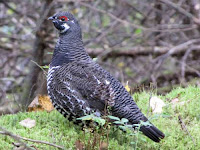 |
| Moose | credit: USFWS |
Its mountains and forests are inhabited by black bear, moose, deer, beaver, marten, weasels, rabbits, hares, foxes, bobcat, lynx, eagles, hawks, owls, turkey, grouse, songbirds, and others.
Along the coast and out at sea, there are whales, porpoises, seals, sea turtles, waterfowl, sea birds, and other marine life.
Maine
With an abundance of sparsely populated woodlands and miles of rugged coasts, Maine is one of the best states for wildlife watching.
The moose is the largest of Maine's land animals and one of its most popular wildlife attractions. Other mammals seen in backwoods Maine include white-tailed deer, black bear, red fox, bobcats, beaver, and others. Maine is one of the few U.S. states where Canada lynx and American marten can be seen in the wild.
Winding through wilderness areas, the Appalachian National Scenic Trail offers miles of areas for wildlife watching. In the Highlands Region, Moosehead Lake is a popular destination for wildlife watching and other recreational activities.
New Hampshire
New Hampshire is known for its rugged mountains and extensive woodlands, where human populations are not a major stress on wildlife. While exploring the state's wild areas, visitors may encounter moose, white-tailed deer, black bear, red fox, bobcats, and others.
Vermont
 |
| Spruce Grouse | credit: USFWS |
Vermont's extensive forests are home to an array of birds. Woodland birdwatchers encounter ruffed grouse, American woodcock, gray jay, woodpeckers, chickadees, thrushes, flycatchers, numerous warblers, hawks, wood ducks, cedar waxwings, pine siskin, and other forest-dwelling birds.
Northern Vermont is one of the few places in the USA where birdwatchers may encounter spruce grouse. Northern Vermont is also a good area to encounter mammals such as snowshoe hare, beaver, American marten, red fox, gray fox, eastern bobcat,and others.
In Vermont's Northeast Kingdom, bogs and wetlands are prime areas for moose watching. Moose are spotted at West Mountain, Wenlock WMA, Victory Basin WMA, Conte National Wildlife Refuge, and Victory State Forest.
In southwestern and central Vermont, the Green Mountain National Forest (GMNF) is a popular area for wildlife watching. The forest is known for its moose and black bear, as well as smaller species of wildlife.
Massachusetts
 |
| Seals at Nantucket beach | credit: USFWS |
Cape Cod, one of the state's most popular areas, is known for its seals.
Off the coast, Nantucket and Martha's Vineyard provide unique habitats for marine mammals, sea birds, and other wildlife.
In western Massachusetts, the Berkshire Mountains region is popular for wildlife watching and other outdoor recreation.
Rhode Island
Rhode Island has a wealth of natural resources including 400 miles of coastline, state parks, trails, and other areas where wildlife can be enjoyed.
Birdwatchers will find year round opportunities in Rhode Island. During the spring and fall migrations, the state is visited by a wide range of birds. In summer, resident birds are jointed by breeding populations of ospreys, shorebirds, and others. In winter, Rhode Island is visited by ducks, geese, bald eagles, hawks, falcons, and others.
Connecticut
Connecticut has a variety of wildlife watching areas such as the Litchfield Hills, Connecticut River Valley, Eastern Highlands, and Long Island Sound.
Hikers and wildlife watchers are sometimes surprised by a black bear encounter. According to the Connecticut Department of Energy and Environmental Protection (DEEP), black bears are becoming increasingly common in Connecticut.
In the mountains, forests and backwoods of Connecticut, nature enthusiasts may also see white-tailed deer and a variety of smaller mammals.
Along the coast, seals, porpoises, whales, waterfowl, and marine birds are sometimes spotted.
Species of Concern
The New England cottontail lives in parts of New England and New York. Over the last 50 years, New England cottontail populations have declined sharply.
Loss of habitat is cited as a major factor in the decline of New England cottontails. Development has taken much land once inhabited by cottontails and other wildlife.
Currently, New England cottontails occupy less than 1/ 5th of their historical range. These unique rabbits are found in southern Maine, southern New Hampshire, and parts of Massachusetts, Connecticut, Rhode Island, and New York east of the Hudson River.
For more information about New England cottontails, visit newenglandcottontail.org.
Related Information
Posts labeled wildlife
New Hampshire Rabbit Reports
Where is New England?
No comments:
Post a Comment